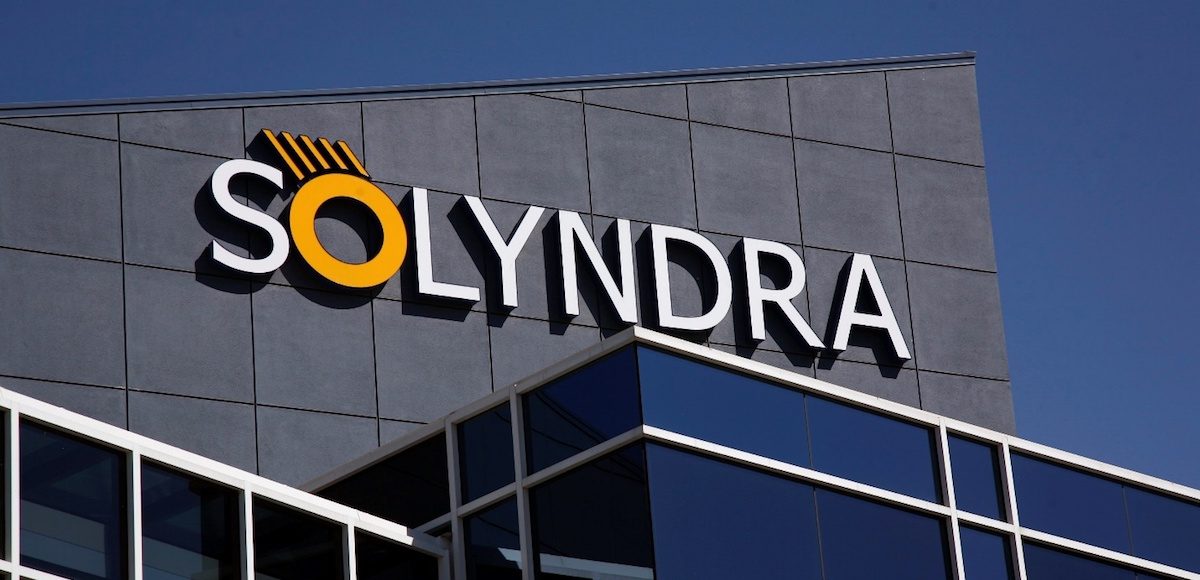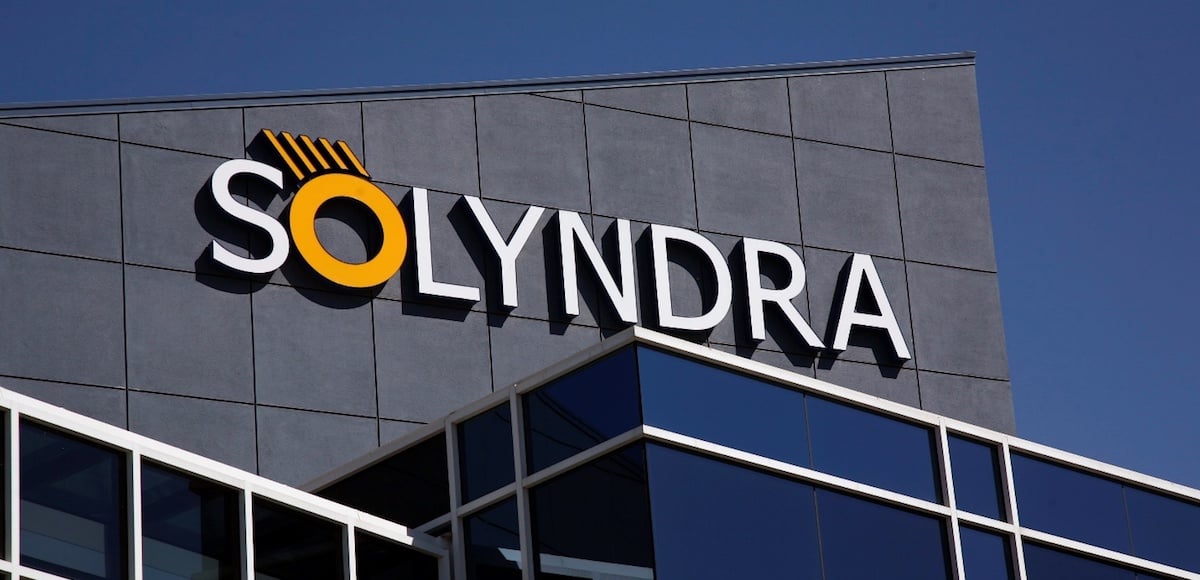

The headquarters of bankrupt Solyndra LLC is shown in Fremont, California, September 20, 2011. (Photo: Reuters)
I have a fantasy of junking the entire corrupt tax system and adopting a simple and fair flat tax. I have an even bigger fantasy of shrinking the size and scope of the federal government to what America’s Founders intended, in which case Washington wouldn’t need any broad-based tax.
But in the real world, where I know “public choice” determines political behavior, I have much more limited hopes and dreams.
I’ve been saying for months that tax reform will be a worthwhile success if it leads to a significantly lower corporate tax rate and the elimination of the deduction for state and local income taxes.
And I recently added repeal of the death tax as a third item that would make me very happy.
Now let’s add a fourth item to my wish-list. The House version of tax reform actually does a decent job of curtailing some of the egregious distortions that line the pocket of companies that peddle so-called green energy.
I know it must be a decent job since the GOP plan is causing angst for leftist journalists.
The Republican-controlled House of Representatives…bill would slash incentives for renewable energy and the electric car industry. Environmental groups are frantic. …The House provision raising the most ire are proposed changes tothe renewable electricity production tax credit, which benefits producers of wind, solar, geothermal and other types of renewable energy. …The House GOP plan would also repeal the Investment Tax Credit for big solar projects that start construction after 2027. House Republicans also propose eliminating the $7,500 credit for electric vehicle purchases. …the Senate bill may not include all of the House’s cuts to clean energy.
It is true that the Senate bill is very timid. But given that there will be a lot of pressure to find “offsets” in any final deal, I’m vaguely hopeful that some of the good provisions in the House bill will survive.
Let’s explore why that would be a very good outcome.
Veronique de Rugy of the Mercatus Center is not a fan of cronyist subsidies to solar energy.
Under President Barack Obama, green energy subsidies were given out like candy. The failure of solar panel company Solyndra is well-known, but the problem extends well beyond the shady loan deal and its half-billion-dollar cost to taxpayers. Between 2010 and 2013, federal subsidies for solar energy aloneincreased by about 500 percent, from $1.1 billion to $5.3 billion (according to the U.S. Energy Information Administration), and all federal renewable energy subsidies grew from $8.6 billion to $13.2 billion over the same period. …However, that didn’t stop the largest U.S. solar panel manufacturer, SolarWorld, from filing for bankruptcy earlier this year despite $115 million in federal and state grants and tax subsidies since 2012, along with $91 million in federal loan guarantees. SolarWorld and fellow bankrupt manufacturer Suniva are now begging for even more government assistance, in the form of a 40-cent-per-watt tariff on solar imports and a minimum price of 78 cents (including the 40-cent tariff) a watt on solar panels made by foreign manufacturers.
Mark Perry of the American Enterprise Institute explains that wind energy is reliant on taxpayer handouts.
…government data shows that offshore wind power cannot survive in a competitive environment without huge taxpayer subsidies. Today, wind power receives subsidies greater than any other form of energy per unit of actual energy produced. …public subsidies for wind on a per megawatt-hour basis are 26 times those for fossil fuels and 16 times those for nuclear power. …The tax credit gives $23 for every megawatt-hour of electricity a wind turbine generates during the first 10 years of operation. …Yet, even with these incentives, only 4.7 percent of the nation’s electricity is currently supplied by wind power and that is entirely wind power from on-land turbines. …Think about it: Four large power plants could produce as much electricity as offshore wind turbines placed side by side along the entire Atlantic seaboard from Maine to Florida. Moreover, power plants last longer than wind turbines. A British study found that turbines need to be replaced within 12 to 15 years, and they must be imported from Europe.
Given the disgusting nature of ethanol subsidies, I wonder whether Mark’s headline can possibly be accurate.
In any event, Senator Alexander of Tennessee agrees that wind subsidies are a bad idea.
As we look at all the wasteful and unnecessary tax breaks that are holding us back, I have a nomination: At the top of the list should be ending the quarter-century-old wind production tax credit now — not two years from now. This giveaway to wind developers was meant to end in 1999 but has been extended by Congress ten different times. While the wind production tax credit is scheduled to be phased out by the end of 2019, we should do better and end it at the end of this year, and use the $4 billion in savings to lower tax rates. …Congress needs to stop its habit of picking winners and losers in the marketplace. Twenty-five years of picking wind developers over more-reliable sources of electricity hasn’t paid off. Imagine what innovation we might unleash if we used the billions wasted on wind energy to invest in research to help our free-enterprise system provide the abundance of cheap, clean, reliable energy we need to power our 21st-century economy.
A recipient of tax preferences discusses his undeserved benefits in a Wall Street Journal column.
…it’s only appropriate that I express appreciation for the generous subsidy you provided for the 28-panel, four-array, 8,540-watt photovoltaic system I installed on my metal roof last year. Thanks to the investment tax credit, I slashed my 2016 federal tax bill by $7,758. …thanks to the incentives for rooftop solar, I’ve snared three subsidies. …fewer rooftop solar projects are being installed in low-income neighborhoods. …According to a study done for the California Public Utility Commission, residents who have installed solar systems have household incomes 68% higher than the state average. Ashley Brown, executive director of the Harvard Electricity Policy Group, calls the proliferation of rooftop solar systems and the returns they provide to lucky people like me, “a wealth transfer from less affluent ratepayers to more affluent ones.” It is, Mr. Brown says, “Robin Hood in reverse.” Do I feel bad about being a solar freeloader? Yes, a little. …the local barista or school janitor—people who likely can’t afford solar panels—are paying incrementally more for the grid’s maintenance and operation. And the more that people like me install panels, the more those baristas and janitors have to pay.
By the way, the United States is not the only nation with green-energy boondoggles (remember Solyndra?).
I’ve previously written about the failure of such programs in Germany.
Let’s add to that collection with an all-too-typical story from the United Kingdom.
Britain is wasting hundreds of millions of pounds subsidising power stations to burn American wood pellets that do more harm to the climate than the coal they replaced, a study has found. Chopping down trees and transporting wood across the Atlantic Ocean to feed power stations produces more greenhouse gases than much cheaper coal, according to the report. It blames the rush to meet EU renewable energy targets… Green subsidies for wood pellets and other biomass were championed by Chris Huhne when he was Liberal Democrat energy and climate change secretary in the coalition government. Mr Huhne, 62, who was jailed in 2013 for perverting the course of justice, is now European chairman of Zilkha Biomass, a US supplier of wood pellets.
In a perverse way, I admire Mr. Huhne, who didn’t follow the usual revolving-door strategy of politician-to-cronyist. He apparently went politician-to-prisoner-to-cronyist.
If you head north in Great Britain, the foolishness mostly revolves around wind power.
…the blackmailing, money-printing sausage factory is a wind farm in Scotland. There are currently about 750 wind farms north of the border, with roughly 3,000 wind turbines. …The wind farms are distributed across Scotland, sometimes in very remote regions, so there is a real problem in getting their energy down to the English border – let alone getting it across. …Why has so much been built? Partly, it is because of income-support subsidies. This top-up of nearly 100 per cent over the wholesale price – funded, of course, from consumer bills – makes wind farms very attractive… Subsidies to onshore wind in the UK now cost a little under £600 million a year, with Scottish wind taking about half, yet the Scottish government continues to ignore the protests and consent to new wind farms as if they cost almost nothing at all. Which as far as Holyrood is concerned, is in fact true. Part of the attraction for Scottish politicians is that the subsidies that pay for Scottish wind farms come from consumers all over Great Britain. Scottish consumption is about 10 per cent of the British total – so when the Scottish government grants planning permission to the wind industry, it is simply writing a cheque drawn overwhelmingly on English and Welsh accounts. …The result is that there is a perverse incentive to locate wind farms in Scotland, even though they aren’t welcome and the grid can’t take their output.
You won’t be surprised to learn, by the way, that taxpayers in the U.K. have been subsidizing green groups.
From an economic perspective, the bottom line is that green energy is more expensive and it requires subsidies that line the pockets of politically connected people and companies. That’s true in America, and it’s true in other nations.
Which is unfortunate, because it gives a bad name to energy sources that probably will be capable of producing low-cost energy in some point in the future.
Indeed, my long-run optimism about green energy is one of the reasons why I’m such a big believer in capitalism and private property. I just don’t want politicians to intervene today and make it harder to achieve future innovation.






